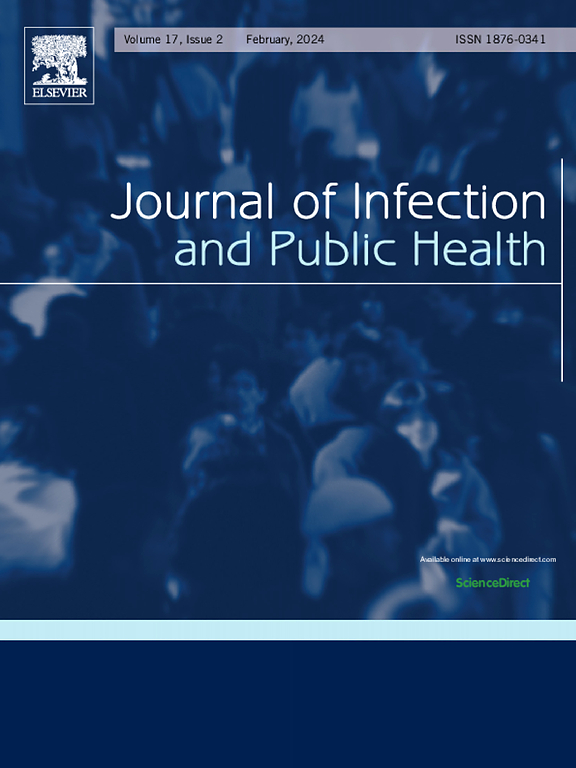Healthcare-associated infection and antimicrobial use among residents of long-term care facilities in Italy: Preliminary results of a point prevalence survey
IF 4
3区 医学
Q1 INFECTIOUS DISEASES
引用次数: 0
Abstract
Background
Healthcare-associated infections (HAIs) are infections acquired in any care setting, including long-term residential facilities, rehabilitation units, and nursing homes, and which were not clinically manifest nor incubating at the time of admission to the facility. HAIs are among the most frequent adverse events encountered in healthcare settings, often caused by multi-resistant microorganisms that can infect patients, healthcare workers, and visitors, causing morbidity and mortality. Surveillance activities such as prevalence studies represent an opportunity to plan preventive actions and improve quality of care in all care contexts.
Methods
A point prevalence survey was conducted in November 2023 among the 22 long-term care facilities (LTCFs) managed by the Don Carlo Gnocchi ONLUS Foundation. Data were collected on a single day in each LTCF, using a web-based data collection methodology developed for the European HALT-4 study. Data collection teams at each facility, including a total of 97 surveyors, completed a survey-questionnaire, following training on the data collection method.
Results
Among the 2746 included residents, the prevalence of residents with at least one HAI was 4.8 % (95 % confidence interval [CI] 4.0 %–5.7 %). HAI prevalence ranged from 1.1 % (95 % CI 0.5 %–1.7 %) in residential care settings to 12.1 % (95 % CI 8.0 %–16.2 %) in intensive rehabilitation units. The prevalence of antimicrobial use was 7.3 % (95 % CI 6.3 %–8.3 %), with prevalence of 2.0 % (95 % CI 1.2 %–2.7 %) for residential care residents, 10.2 % (95 % CI 8.5 %–11.9 %) for non-intensive rehabilitation, and 20.2 % (95 % CI 15.2 %–25.2 %) for intensive rehabilitation.
Conclusions
This initial study allowed the assessment of the feasibility of conducting nationwide studies in various centers, and deepened our understanding of different care settings, as well as the clinical characteristics and complexity of hospitalized patients and residents in LTCFs.
意大利长期护理机构居民中与医疗保健相关的感染和抗菌药物的使用:一项点流行调查的初步结果
背景:卫生保健相关感染(HAIs)是指在任何护理环境中获得的感染,包括长期居住设施、康复单位和疗养院,并且在入院时没有临床表现或潜伏期。HAIs是卫生保健环境中最常见的不良事件之一,通常由多重耐药微生物引起,可感染患者、卫生保健工作者和访客,导致发病率和死亡率。流行病学研究等监测活动为在所有护理环境中规划预防行动和提高护理质量提供了机会。方法于2023年11月对唐·卡洛·诺奇ONLUS基金会管理的22家长期护理机构(ltcf)进行点患病率调查。每个LTCF在一天内收集数据,使用为欧洲HALT-4研究开发的基于网络的数据收集方法。每个设施的数据收集小组,包括总共97名调查员,在接受数据收集方法培训后完成了一份调查问卷。结果2746名纳入调查的居民中,至少有一种HAI的患病率为4.8 %(95% %可信区间[CI] 4.0 % ~ 5.7 %)。HAI患病率范围从寄宿护理机构的1.1 %(95 % CI 0.5 % -1.7 %)到重症康复病房的12.1 %(95 % CI 8.0 % -16.2 %)。抗菌药物使用率为7.3 %(95 %可信区间6.3 % -8.3 %),患病率为2.0 %(95 %可信区间1.2 % -2.7 %)对住宅保健居民来说,10.2 %(95 %可信区间8.5 % -11.9 %)为康复,和20.2 %(95 %可信区间15.2 % -25.2 %)密集的康复。这项初步研究评估了在不同中心开展全国性研究的可行性,加深了我们对不同护理环境、ltcf住院患者和居民的临床特征和复杂性的理解。
本文章由计算机程序翻译,如有差异,请以英文原文为准。
求助全文
约1分钟内获得全文
求助全文
来源期刊

Journal of Infection and Public Health
PUBLIC, ENVIRONMENTAL & OCCUPATIONAL HEALTH -INFECTIOUS DISEASES
CiteScore
13.10
自引率
1.50%
发文量
203
审稿时长
96 days
期刊介绍:
The Journal of Infection and Public Health, first official journal of the Saudi Arabian Ministry of National Guard Health Affairs, King Saud Bin Abdulaziz University for Health Sciences and the Saudi Association for Public Health, aims to be the foremost scientific, peer-reviewed journal encompassing infection prevention and control, microbiology, infectious diseases, public health and the application of healthcare epidemiology to the evaluation of health outcomes. The point of view of the journal is that infection and public health are closely intertwined and that advances in one area will have positive consequences on the other.
The journal will be useful to all health professionals who are partners in the management of patients with communicable diseases, keeping them up to date. The journal is proud to have an international and diverse editorial board that will assist and facilitate the publication of articles that reflect a global view on infection control and public health, as well as emphasizing our focus on supporting the needs of public health practitioners.
It is our aim to improve healthcare by reducing risk of infection and related adverse outcomes by critical review, selection, and dissemination of new and relevant information in the field of infection control, public health and infectious diseases in all healthcare settings and the community.
 求助内容:
求助内容: 应助结果提醒方式:
应助结果提醒方式:


